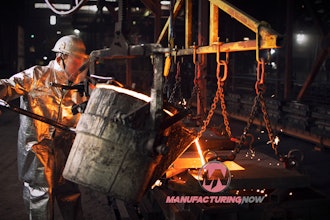By MICHAEL P. COLLINS, Author, Saving American Manufacturing
 The United States has lost 9 million manufacturing jobs since 1979. We used to be the number one exporting nation in the world and have slipped to number three, and have been running trade deficits for many years. Pundits, politicians and manufacturing leaders have attributed the decline of manufacturing in the U.S. to unions, high wages, government regulations, high taxes, lack of skilled workers and a host of other reasons.
The United States has lost 9 million manufacturing jobs since 1979. We used to be the number one exporting nation in the world and have slipped to number three, and have been running trade deficits for many years. Pundits, politicians and manufacturing leaders have attributed the decline of manufacturing in the U.S. to unions, high wages, government regulations, high taxes, lack of skilled workers and a host of other reasons.
To compete, American manufacturers have focused on reducing labor costs, and moving plants and products offshore. America is now an economy with a $14 trillion deficit, 9.1 percent unemployment, 1 percent GDP growth and no light at the end of the proverbial tunnel.
But what about Germany? They have many more unions then we do, highly paid workers, many more government regulations, and high corporate and personal taxes. Yet they must also compete against the unfair trade policies of China and the rest of the world.
However, Germany is now the number two biggest exporter in the world, has a high national savings rate, a 5.5 percent trade surplus and an unemployment rate that is at a 20-year low. So this begs the obvious question — why is Germany’s manufacturing sector and economy doing well, while America’s manufacturing sector continues to decline?
I use the following 10 factors to make the comparison.
1.) Manufacturing as a percentage of GDP. From 1980 to 2008, Germany’s manufacturing sector went from 27 to 21 percent of GDP. During the same period, the American manufacturing sector declined from 21 to 11 percent of GDP.
2.) Corporate taxes. The United States has a 35 percent federal tax and an average 5.57 percent state tax for a total of a 39.54 percent corporate tax rate. Germany has a federal rate of 26.38 percent, plus a state rate of 17 percent for a total corporate tax rate of 38.9 percent. The taxes appear to be comparable, but a study at the University of North Carolina shows that through a myriad of tax breaks, most U.S. manufacturers actually pay around 26 percent.
3.) Operational efficiency. German firms have invested in Lean manufacturing and quality systems, and are devoted to continuous improvement. Germany has and is still seen as a high-quality producer of durable goods. The United States has also invested an enormous amount of money into Lean manufacturing, Six Sigma and ISO 9000 in the last 30 years. It may have taken the U.S. a little longer, but I think we have caught up to Germany, Japan and all other countries in operational efficiency.
4.) Focus on export. Ever since 1948, when Germany’s post-war economy began gaining momentum, the country has focused on export. The country focuses on target markets and aggressively pursues emerging markets. All manufacturers in Germany seem to know how to do export marketing, including small and midsize manufacturers.
Even though the Obama administration has published a goal of doubling U.S. exports in five years, the government does not have a good plan to implement the goal. The problem is that America’s small and midsize manufacturers are not good at marketing and shy away from exporting because they have never had to export in the past.
5.) Professional management. In my own research, I have found that the primary drivers that can grow a small (or even family-owned) manufacturing company into a fast-growing midsize manufacturer are professional managers and modern business systems. A research report by Venohr and Meyer in Germany shows that 60 percent of family-owned companies in Germany hired outside professional managers.
In the U.S., only 30 percent of family-owned companies hire outside professional managers. I have found that family-owned manufacturers in America reach a point in which the family-managed company can no longer grow. It takes modern systems, like cost accounting, production control and good financial statements, along with professional managers, to establish a new platform for real growth — and in particular, expert marketing.
6.) Education and training. Germany has always led the U.S. (if not the world) in investing in an education and training program to provide their country with the skilled workers they need in all industries. Germany is the world leader in investing in apprentice programs for manufacturing that leads to a continuous supply of highly skilled workers.
The U.S. is now experiencing a shortage of skilled workers in many industries, which will only get worse as the 2.7 million baby boomers retire in the next 10 years. As the Germans continued to develop their skill training and technical education, America closed down all of the grade and high school shop classes, underfunded vocational colleges and almost eliminated long-duration apprentice programs from where they were in the 1960s. The U.S. is way behind in technical and apprentice training, which will limit innovation, new products and growth.
7.) Health care costs. Health care costs have grown so rapidly in the U.S. that they are now a big negative factor in American competitiveness. In America, we have 50 million people who have no medical insurance. In Germany, every person is covered whether they are employed or unemployed. It appears that premiums for medical insurance in the U.S. may double in the next 10 years, becoming a huge problem for manufacturers and other businesses. This whole problem begs the question of how can Germany and other European countries offer health care to more people and at a lower cost.
8.) Unemployment. Since the recession started in late 2007, the U.S. has had an unemployment rate of more than 9 percent or 13.9 million people. When you add in the 6 million underemployed people searching for full-time work, it is 20 million people looking. The answer in the U.S. has been unemployment benefits, which serve as a continual debate in Congress in terms of when to cut off unemployment compensation.
Instead of just laying off people, Germany followed a policy of trying ways to keep people employed. Germans came up with the “Kurzarbeit” or “short-term work” program to encourage employers to furlough workers or give them fewer hours instead of firing them. The German government makes up their lost wages to keep them employed. This allows German companies to retain people rather than dealing with their problems once they are lost, thus retaining employees when the economy comes back — which it did.
9.) Management/labor/government cooperation. When you listen to the nightly news, it sounds like we are witnessing a final showdown between management and labor in a zero sum game in which the government plays some kind of vague role of referee. In an op-ed article, Harold Myerson writes, “The German manufacturing sector is highly unionized and, by law, these unions sit on the board of directors of corporations. German elites seem to recognize far better than American elites that any sustainable social contract must benefit all of society, or it will be wracked with costly dissension and non-cooperation. The Germans learned the hard way that it is better to care for and respect each other rather than hate each other.”
Because of this cooperation, German unions felt they could have a hand in building a strong recovery and growth. In the last decade, the unions volunteered for wage restraints that kept German manufacturers competitive. It is this kind of cooperation that is not evident in the U.S. in any industry. Whether you like this idea or not, Germany has an advantage over the U.S. It suggests management is going to have to work harder to enlist the support of manufacturing employees in our worldwide war to keep American manufacturing competitiveness relevant.
10.) Trade deficits and surpluses. This is perhaps the most important factor of all. While the U.S. stays completely devoted to free trade, we are being beaten (no, killed) by mercantile nations like China. The U.S. continues to follow a free trade doctrine of trade deficits, which was $498 billion in 2010, while other countries manipulate their currencies or implement policies that will always give them a surplus. The fact is that, politically and economically, the U.S. will not be able to sustain these kinds of deficits and continue to borrow (and print) the money to pay for them.
Germany, on the other hand, has never allowed their nation to slip into the problem of trade deficits. Germany has a 19 percent value-added tax (VAT) for all goods passing the border of Germany. The U.S. does not have a VAT even though they are legal under WTO rules. Germany also employs all kinds of government red tape for anyone trying to penetrate their markets. In addition, Germany has an import duty on most imported goods, which is 10 percent plus freight costs plus freight insurance.
On the other hand, if Germany exports goods to America, their products enter the U.S. without a VAT or import duty. The Germans are not absolutely consistent with these barriers on all imported goods, but they employ them surgically to always ensure that they end up with a year-end surplus.
America is not Germany and has a very different culture, but Germany has found ways to strengthen their manufacturing sector and control their finances. I am not advocating that America copy the German model or their methodologies, I am simply pointing out that, just like China, Germany has many advantages over the U.S. — both fair and unfair. We are losing the battle of exports and our free trade approach has not worked or leveled the playing field for many years.
I think that it is time to take a fresh look at what may be required to save American manufacturing. Simply accepting huge trade deficits, printing more money, spiraling health care costs and declining manufacturing as necessary to support free trade and avoid protectionism is a fool’s errand. Our financial situation is not sustainable, and sooner or later there is going to be an economic reset.
Michael P. Collins is the author of the book Saving American Manufacturing. You can find more related articles on his website via www.mpcmgt.com.


















